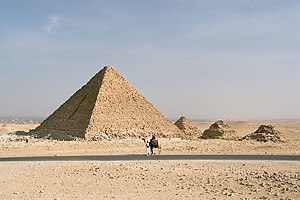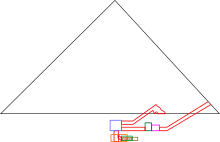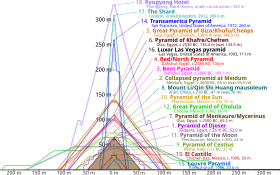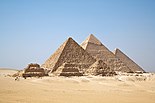Pyramid of Menkaure
| Pyramid of Menkaure | |
|---|---|
 The pyramid in 2004 | |
| Menkaure | |
| Coordinates | 29°58′21″N 31°07′42″E / 29.97250°N 31.12833°E |
| Ancient name | |
| Constructed | c. 2510 BC (4th dynasty) |
| Type | True Pyramid |
| Material | limestone, core red granite, white limestone, casing |
| Height | 65 metres (213 ft) or 125 cubits (original) |
| Base | 102.2 by 104.6 metres (335 ft × 343 ft) or 200 cubits (original) |
| Volume | 235,183 cubic metres (8,305,409 cu ft) |
| Slope | 51°20'25'' |
The pyramid of Menkaure is the smallest of the three main pyramids of the Giza pyramid complex, located on the Giza Plateau in the southwestern outskirts of Cairo, Egypt. It is thought to have been built to serve as the tomb of the Fourth Dynasty King Menkaure.
Size and construction
[edit]
Menkaure's pyramid had an original height of 65.5 meters (215 ft), and was the smallest of the three major pyramids at the Giza Necropolis. It now stands at 61 m (200 ft) tall with a base of 108.5 m (356 ft). Its angle of incline is approximately 51°20′25″. It was constructed of limestone and Aswan granite. The upper portion was cased in the normal manner with Tura limestone. The construction of the outer casing of the pyramid was halted at sixteen to eighteen layers of granite following Menkaure's death, only seven of which remain today due to vandalism and erosion.[2][3] Part of the granite was left in the rough.
The descending passage to lower burial chamber is in the 'large apartment' floor, probably original hidden by floor blocks.[4] It is theorised that originally the pyramid was planned to be smaller. The blind alley being the originally planned entrance passage.[5]
A boat hieroglyph was found painted on a limestone block near the pyramid, which may indicate the presence of a boat pit for a solar barque.[6]
Age and location
[edit]The pyramid's date of construction is unknown, because Menkaure's reign has not been accurately defined, but it was probably completed in the 26th century BC.[citation needed] It is a few hundred meters southwest of its larger neighbors, the pyramid of Khafre and the Great Pyramid of Khufu in the Giza necropolis.
Sarcophagus and coffin
[edit]
In 1837, Howard Vyse and John Shae Perring discovered the basalt sarcophagus of Menkaure, described as beautiful black and rich in detail with a bold projecting cornice, which contained the bones of a young woman. It was loaded onto the ship Beatrice, but wrecked off the Spanish coast on the way to Great Britain.[7]

A wooden anthropoid coffin inscribed with Menkaure's name and containing the remains of a mummy were found in the upper burial chamber and later transferred safely to the British Museum.[7] The coffin was radiocarbon dated to 1212–846 BC, from the late New Kingdom to the Third Intermediate Period. The male body and its shroud were carbon dated to the early Islamic Period.[8]
Pyramid complex
[edit]Pyramid temple
[edit]In the mortuary temple, the foundations and the inner core were made of limestone. The floors were begun with granite and granite facings were added to some of the walls. The foundations of the valley temple were made of stone. Both temples were finished with crude bricks. Reisner estimated that some of the blocks of local stone in the walls of the mortuary temple weighed as much as 220 tons. The heaviest granite ashlars imported from Aswan weighed more than 30 tons.
It is assumed that Menkaure's successor Shepseskaf completed the temple construction. An inscription was found in the mortuary temple that said he "made it (the temple) as his monument for his father, the king of upper and lower Egypt."
Subsequent architectural additions and two stelae from the Sixth Dynasty suggest that a cult for the Pharaoh was maintained, or was periodically renewed, for two centuries after his death.[9]
Valley temple
[edit]The Menkaure Valley temple was excavated between 1908 and 1910 by American archaeologist George Andrew Reisner.[9] He found a large number of statues, mostly of Menkaure alone, and as a member of a group. These were all carved in the naturalistic style of the Old Kingdom, with a high degree of detail.[10]
Queens' pyramids
[edit]
South of the pyramid of Menkaure are three smaller pyramids, designated G3-a, G3-b, and G3-c, each accompanied by a temple and substructure. The easternmost is the largest and a true pyramid. Its casing is partly of granite, like the main pyramid, and is believed to have been completed due to the limestone pyramidion found close by.[11] Neither of the other two progressed beyond the construction of the inner core.[10]
Reisner speculated that the structures were likely tombs for the queens of Menkaure, and that the individuals buried there may have been his half-sisters.[12] The archaeologist Mark Lehner argues that pyramid G3-a has a layout akin to a ka pyramid, which would have housed a statue of the king rather than a body. The fact that the structure once contained a pink granite sarcophagus,[13] has led scholars to speculate that it may have been reused as a queen's burial tomb, or that it served as a chapel where the body of Menkaure was mummified.[14]
Attempted demolition
[edit]
In 1196, Al-Aziz Uthman, Saladin's son and the Sultan of Egypt, attempted to demolish the pyramids, starting with that of Menkaure. Workmen recruited to demolish the pyramid stayed at their job for eight months, but the task was expensive and slow. Workers were only able to remove one or two stones each day at most. Some used wedges and levers to move the stones, while others used ropes to pull them down.[15][16]
When a stone fell, it would bury itself in the sand, requiring extraordinary efforts to free it. Wedges were used to split the stones into several pieces, and a cart was used to carry it to the foot of the escarpment, where it was left. Despite their efforts, workmen were only able to damage the pyramid to the extent of leaving a large vertical gash at its northern face.[15][16]
Restoration attempt
[edit]
In January 2024, a project to study and document the outer granite blocks which had fallen off of the facade began, with the goal to reinstall them.[18] The project was planned to take three years to complete.[19][20] Weeks after the announcement, the project was cancelled following backlash by researchers and a report by a team of experts called in by Egyptian officials and led by Zahi Hawass, Egypt’s former minister of antiquities which “unanimously objected to the re-installation of the granite casing blocks scattered around the base of the pyramid”.[21]
See also
[edit]References
[edit]- ^ Verner 2001, p. 242.
- ^ Werr, Patrick (February 16, 2024). "Egypt aborts controversial pyramid renovation plan". Reuters. Retrieved August 11, 2024.
- ^ Samaan, Magdy (29 January 2024). "Rebuilding granite blocks around pyramid 'as absurd as straightening the Tower of Pisa'". The Daily Telegraph. Retrieved August 11, 2024.
- ^ "Chapter 8: Menkaure and the Colonel – The Analog Antiquarian". 2019-04-26. Retrieved 2024-03-17.
- ^ "NOVA Online/Pyramids/Cross-Section of Menkaure's Pyramid". www.pbs.org. Retrieved 2024-03-17.
- ^ Jenkins, Nancy (1980). The Boat Beneath the Pyramid. London: Thames and Hudson. pp. 157, 159. ISBN 9780030570612.
- ^ a b Hawass, Zahi. "The Pyramids at Giza: Khafre and Menkaure". Archived from the original on 2007-09-27. Retrieved 2007-09-26.
- ^ Strouhal, Eugen; Vyhnánek; Gaballah; Saunders; Woelfli; Bonani; Němečková (2001). "Identification of royal skeletal remains from Egyptian pyramids" (PDF). Anthropologie. 39 (1): 18–19.
- ^ a b Lehner, Mark in: Manuelian, Peter Der; Schneider, Thomas (30 October 2015). Towards a New History for the Egyptian Old Kingdom: Perspectives on the Pyramid Age. ISBN 9789004301894.
- ^ a b Edwards, I. E. S.: The Pyramids of Egypt 1986/1947 pp. 147–163 [ISBN missing]
- ^ Janosi, Peter. "Das Pyramidion der Pyramide G III-a" (PDF).
- ^ Reisner, George Andrew (1942). A History of the Giza Necropolis. Vol. III. Harvard University. pp. 186–187. (Note: This is the second unpublished follow-up to Reisner's work A History of the Giza Necropolis Vol. I, published by Harvard University Press)
- ^ Verner, Miroslav (2007). The Pyramids: The Mystery, Culture, and Science of Egypt's Great Monuments. New York City, NY: Grove Atlantic. p. 252. ISBN 9780802198631.
- ^ Lehner 1997, pp. 134, 136.
- ^ a b Stewart, Desmond (June 1, 1971). The Pyramids and Sphinx. Wonders of Man Series. Newsweek. p. 101. ISBN 978-0276000164.
- ^ a b Lehner 1997, p. 41.
- ^ Lehner 1997, p. 221.
- ^ Samir, Salwa (January 25, 2024). "In a first, outer casing of Menkaure's pyramid to be studied, reassembled". The Egyptian Gazette. Retrieved August 14, 2024.
- ^ ""مشروع القرن".. ماذا تخطط مصر للهرم الثالث؟" ["Project of the Century" - What is Egypt planning for the third pyramid?]. Al Arabiya (in Arabic). January 26, 2024. Retrieved August 14, 2024.
- ^ Khaled, Raghad (January 26, 2024). "Tourism Ministry Begins Project To Install Granite Coverage On Menkaure Pyramid". lovin cairo. Retrieved August 14, 2024.
- ^ Anderson, Sonja (February 20, 2024). "Egypt Halts Controversial Plans to Renovate Ancient Pyramid". Smithsonian magazine. Retrieved August 14, 2024.
Further reading
[edit]- Verner, Miroslav (2001). The Pyramids: The Mystery, Culture and Science of Egypt's Great Monuments. New York: Grove Press. ISBN 978-0-8021-1703-8.
- Lehner, Mark (1997). The Complete Pyramids: Solving the Ancient Mysteries. London: Thames & Hudson. ISBN 0-500-05084-8.

External links
[edit]

